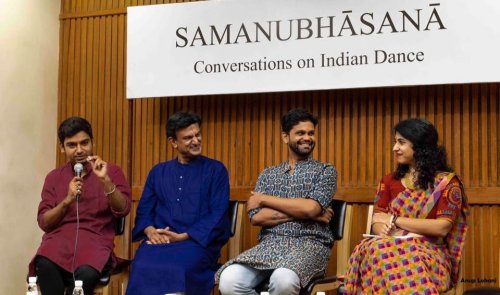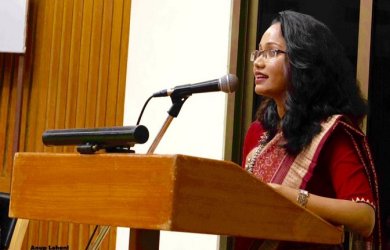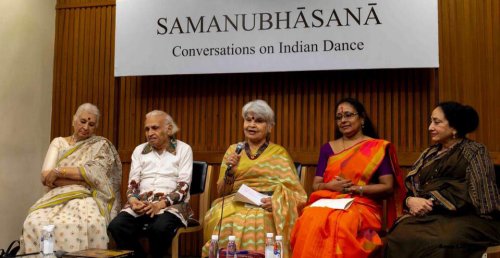
|   |

|   |
 e-mail: leelakaverivenkat@gmail.com Endemic problems stir animated discourse Photos courtesy: Prachi Hota October 14, 2019 Prachi Hota's planning of a discussion Samanubhasana mounted at the IIC Annex provided a good platform for a free exchange of views on certain issues which the arena of classical dance will always have to contend with. It is encouraging to see youngsters in the dance world willing to participate in panel discussions, unafraid of expressing their views on various subjects. The first subject of 'Understanding the Pay and Perform Culture' never ceases to stir high passions and righteous indignation. Bharatanatyam dancer Tanya Saxena, a disciple of Saroja Vaidyanathan, provided an excellent start to the discussions with her well thought out, clear-headed introduction summing up all the aspects of this hydra headed monster which makes a dancer pay the organizers for a platform to perform, rather than being paid for her services. The exploitation comes in a host of packages - like providing an 'honorarium' which is for 'production costs' by the sponsor who of course gives the performer nothing; asking the dancer to manage with a lump sum provided (within which all expenses of light, sound, fee for the musicians etc have to be met); allowing the dancer to perform to recorded music and providing hospitality for the day (but never travel costs from another city); mentioning that the organization cannot afford to pay but will provide a stage and an audience (!); charging a 'registration' fee for organizing etc. "Where does one draw the line?" asked the dancer. While money is a big concern, it may not be the sole criterion. The organization and the size of the audience, if fairly good, are matters of deep importance to a dancer. One can console oneself that through such a program one can cultivate a relationship providing goodwill, which hopefully will help one's future prospects. Tanya also made a forceful statement about none of these so called events (taking advantage of young dancers looking for a platform) being curated with care. They are haphazard with nobody to oversee events, even though the stage comes at a price. The dancer made out a strong case for dancers who seem particularly vulnerable to this state of affairs, with their also acquiring, over the years, a pitiful image of constantly having to beg for money. Musicians get a better deal.Why is it only the dancer who is supposed to provide entertainment with no compensation for her efforts? Vasudevan Iyengar, dancer, guru and shishya rolled in one said that it was important to ask oneself, 'Why and for whom one is dancing.' Investment is always involved in any type of education, for it starts with gurudakshina for the teacher. In the past, the gurus were invited to come and perform and this came as a great treat for the students and connoisseurs. In those days there were very few gurus. Today it is a pure question of supply and demand that operates in a dance world which is entirely market oriented. Forget about spirituality and all the old arguments. You are living in a different world today and you must learn to adjust by being frank with yourself on why one is learning the art - is it just to earn a living or is it for you a traditional sacred vehicle which you cannot bring down, in a market driven world, driven by money. Ultimately you are the decider. Paying is an option and the individual decides whether he will accept it or not.  Himanshu Srivastava, S Vasudevan, Vinod Kevin Bachan, Tanya Saxena Trinidadian dancer, an Odissi performer, now under the tutelage of Ranjana Gauhar, Vinod Kevin Bachan referred to the dancer of today having to hunt for opportunities to inform in a climate where dance would seem to have become a business for both organizers and dancers. It is no longer moonshine and roses and with having to pay to perform, are we, one wonders losing the essence of art? When somebody in the past said, "So you are a dancer!" it was with a different sense of wonder than a person today reacting "Oh, so you are a dancer." The difference in intonation says it all. A Bharatanatyam dancer and also a painter, Himanshu Srivastava who hails from Allahabad and is now learning under Guru Saroja Vaidyanathan, to judge from his statements, has the right attitude. Asserting firmly that the ultimate decision rests with the dancer, he cited his own example. He had given up a good salary since he was known as an artist, to move to Delhi and learn Bharatanatyam. But till he is able to establish himself to the extent of being able to survive only through dance, his painting is what he relies upon to support himself. This has spared him from the humiliations of giving in to organizers living by exploiting dancers. By surrendering to the guru and holding up the dignity of dance and dancer, he felt he was "holding a torch - though very small and showing some light to other dancers" nursing the same hopes of progressing to some form of success. Passionate responses from the audience also saw dancer/teacher Sharon Lowen blame critics who are on the selection panel of the IIC, for not fighting for and ensuring better terms for dancers - with seniors called to perform for a remuneration of 10,000 rupees! While the sentiments are understandable, in defense of critics and the IIC, it must be understood that the selection committee watches videos for hours to voice opinions about dozens of dancers who apply. While one may informally refer to remuneration, it does not feature as part of their duty. And IIC whose constitution does not allow raising funds through advertisements or publicity, depends purely on what its Membership Fee brings in. With many departments to cater to, the larger cultural events, barring the IIC Festival, are endeavours mounted through collaborations. For dance and music evenings solely organized by them, featuring solo and double bill concerts, the compensation they are able to provide is clearly stated and it is up to the artist to agree or not. And expecting critics to refuse to cover IIC events, unless the artist is 'adequately' compensated, is not just high handed, but is not going to change matters. It is entirely up to the artist - and nobody and nothing is forcing one to agree to the terms offered by the IIC - which puts all the cards on the table and has nothing to hide. It goes without saying that unless all dancers, without exceptions, decline offers which take advantage of them or do not adequately compensate, steadfastly refusing to be tempted (some pay for platforms because they can afford to), no matter how prestigious the venue, one cannot see any changes coming into the performance scene. Artists need to unite and to form a forum and also arrange for the aspiring young dancers, some space like the new 'Nava Pallav' effort begun by Spic Macay - which in some cities like Bhubaneswar, Kolkata, Aurangabad is beginning to make a difference.  Prachi Hota The next session involving more senior participants on 'Tradition and experimentation in choreography and practice of Indian dance' had an introductory guide note penned by Prachi herself. Stating that going deeper into a tradition and innovating, one only expands and enriches a tradition, Prachi asked the question if time and historicity alone characterized tradition. Choreography per se is based on a full recognition of the artist's individuality. India with about 16,500 spoken languages (dialects) has a rich literary history, and 'Bhasha' or language forms a defining aspect of every tradition. With so much literary material, why then does an Indian choreographer have to take recourse to a language like English? With so many classical dances, can melding into one other be an acceptable trait in experimentation? Should experimentation be only through subversion? Summing up the definition terms like Tradition and Experimentation, Manjari Sinha, the moderator for the session, asked senior most critic Dr.Sunil Kothari to speak on how he looked at experimentation in tradition. For him the prime examples were late Mrinalini Sarabhai who with her strict and orthodox Bharatanatyam training under Guru Muthukumara Pillai followed by years in Santiniketan at the feet of Rabindranath Tagore (who was the best example of a person who revered tradition and felt that it had to cater to the contemporary sensibility with changes which did not compromise the tradition) her many productions experimented without breaking tradition.All these were keenly seen by Sunil Kothari. The next person who for him represented modernity in tradition was Chandralekha. One had to have a scholarly bent of mind which gave the individual artist the breath of vision to understand the full potential of a tradition and how it could apply and accommodate the contemporary sensibility.  Leela Venkataraman, Dr.Sunil Kothari, Manjari Sinha, Jayaprabha Menon, Sharon Lowen When asked to comment on her own experimental ventures, Mohiniattam practitioner Jayaprabha Menon, despite her misgivings about inadequacy in participating in such discussions (being more a practicing dancer), very clearly described how the traditional repertoire while great, could not satisfy her urge to try out new themes. Her initial ventures kept in mind subjects which would ideally suit the graceful and slow technique of Mohiniattam. But gradually emboldened, she became more relaxed starting with her initial venture based on Kalidasa's Ritusamhara with the music by Kavalam Narayana Panikker whose score in the typical aakara style of Sopanam Sangeetam, used rhythmic syllables which onomatopoeically suited the falling of rain drops on the banana leaves during the monsoons. Then she tried her hand at choreographing a very philosophical poem by Shankaracharya, 'Bhaja Govindam' dealing with man's life from birth to death - the futility of too much aspiration and the wisdom of striving for enriching one's inner self rather than acquiring superficial wealth. Set to Chempada talam of 7 beats, Jayaprabha's choreography taking recourse to depths of abhinaya, was much appreciated. Her Naagatatvam based on Kundalini Paat of Narayana Guru had to interpret the song of the snake charmer Aadu paambe, vilaiyaadu paambe with the Teero Tiruteeru vaitharis wherein the charmer invites the Naga to watch the Ananda nritta of Lord Shiva -also a reference to the awakening of the chakra for the Sahasrara. Kalaripayattu movements were used to imitate the snake like curves and for the Tandava nritta, the Kathakali elements were adopted. So it was a challenge to accommodate all this within the Mohiniattam movement technique. Teacher/dancer Sharon Lowen expressed her conviction that having inherited her Odissi legacy from a great guru like Kelucharan Mohapatra, one of the founders of the tradition and a fine choreographer, she saw absolutely no need to tinker with the form, as is being done nowadays. It was the Carnatic vocal genius Balamurali Krishna, who first suggested to her that she could try and choreograph items based on musical compositions dealing with subjects that were close to the Odissi sensibility. But throughout her career, she was decided that certain compositions like "Brajaku Chora" (choreographed by Kelucharan with music by Bhubaneswar Misra) which were contrary to her way of thinking, would not be danced by her. She had steadfastly refused to include in her repertoire any of such items. Her thinking disapproved of a mother putting her baby to sleep narrating a disturbing tale about a thief having crept into the town to abduct all children who refused to go to bed in time in Vraj. (Yashoda is shown putting a recalcitrant young Krishna to sleep. "Last thing a Mother should do, and I cannot bring myself to ever present that item." When this writer was asked to 'briefly' mention what experimentation in tradition meant, I spoke of how relating and making relevant the inherited dance legacy which came from years of practice, to the contemporary period, could mean different things to different artists. But one criterion should be to see that the identity of the form is retained and not lost in creating new work. Knowing the language the dance form has been part of, is very essential. Mentioning some of the poetic metaphor which can lend itself to several extended meanings in new work which one may choreograph, my feeling was that choreography if constantly alienated from the language of the soil which has given birth to the art tradition, can in some cases lead to a straying away from its intrinsic quality. The performance situation can bring with it its own features which dilute the identity. In Odissi for instance, the long struggles to get its music declared as 'classical' created a peculiar situation wherein an artificial exaggeration of grammar and virtuosity has led to the 'bhav' in the traditional music (which is its most gripping quality), getting erased in the classical ornamentation. And with the great gurus having passed by, liberties taken with the form, some consciously and others unconsciously seeping in with influences of the global arena, can bring about unforeseen changes in identity. It was clear that these issues will always stir a debate. That young dancers are concerning themselves with these important aspects of the art form, is all to the good.  Writing on the dance scene for the last forty years, Leela Venkataraman's incisive comments on performances of all dance forms, participation in dance discussions both in India and abroad, and as a regular contributor to Hindu Friday Review, journals like Sruti and Nartanam, makes her voice respected for its balanced critiquing. She is the author of several books like Indian Classical dance: Tradition in Transition, Classical Dance in India and Indian Classical dance: The Renaissance and Beyond. Post your comments Please provide your name and email id when you use the Anonymous profile in the blog to post a comment. All appropriate comments posted with name and email id in the blog will also be featured in the site. |